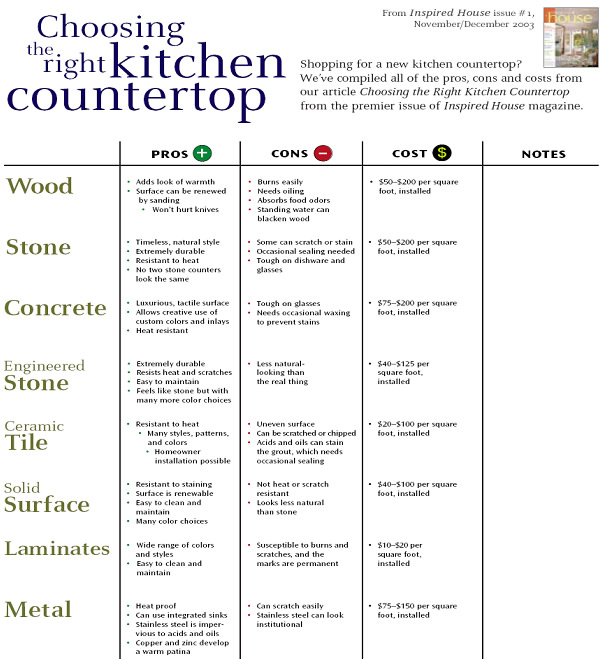Choosing a Countertop Material
We realize choosing a countertop material is a big decision and requires that many considerations be taken into account. Appearance, strength, durability, sustainability and, of course, price are key factors in making a choice that will leave you satisfied and, ultimately, proud. Some common options on the market today are plastic laminates, ceramic tile, stainless steel, concrete, natural stones (marble, granite, slate, soapstone) and wood. Among these options, granite has the most advantages that make it adaptable to the kitchen. Disadvantages and advantages of common countertop materials are given in the comparison chart below.
While some synthetic surfaces scratch easily and melt under hot cookware, granite resists heat. Granite is also one of the most bacteria-resistant kitchen surfaces, and it is not affected by citric acid, coffee, tea, alcohol, or wine. It is also nearly impossible to scratch, and with proper cleaning, will not stain under normal use.
Several years ago, one of the leading home improvement magazines – Inspired House – compared granite with engineered stone, ceramic tile, laminate, butcher block, and other manufactured surfaces. Below you will find this comparison chart:
We have prepared a more detailed and updated comparison for our clients:
GRANITE vs. OTHER COUNTERTOP SURFACES
| Granite | Engineered Stone | Acrylic an/or Polyester Plastics | Tile | Laminates | |
|---|---|---|---|---|---|
| Brand Names | Silestone, Ceasarstone, Cambria, Technistone, Zodiaq | Corian, Staron, Gibraltar, Avonite, Surell, Hi-Macs | Wilsonart, Formica, Nevamar, Pinoite, Arbortite | ||
| What is it? | 100% Natural stone quarried from within the earth | Man-made: 85%-95% crushed quartz with a resin binder | Man-made: Acrylic or Polyester Plastics | Man-made: Ceramic or Porcelain | Man-made: Printed colors/patterns on a fiberglass backing |
| Heat Resistance | Not affected by heat | Can be affected by high heat (over 400F) | Hot pots can warp, melt, crack, or discolor the surface | Not affected by heat | Hot pots can warp, melt, or discolor the surface |
| Cleanliness | Independent studies have found granite to be one of the most bacteria-resistant surfaces available | Non-porous – very resistant to bacteria | Deep scratches can harbor dirt and or moisture | Grout is very porous and can be difficult to keep clean | Non-porous – easy to clean |
| Scratch Resistance | Highly scratch resistant – small scratches can be professionally repaired | Highly scratch resistant | Scratches easily – can be sanded | Finish can be scratched and is usually not repairable | Can be scratched – not easily repaired |
| Installation | May require seams – various edge profiles available | May require seams – various edge profiles available | Seamless – usually set on a wood sub-structure – various edge profiles available | Should be set on an approved sub-structure – limited edge profiles | Sheet material is applied to a wood sub-structure – limited edge profiles |
| Appearance | Highly polished finish – every piece is naturally unique in color and patterning | Polished finish – consistent and uniform color and patterning | Matte finish – with consistent and uniform color and patterning | Grout joints can vary greatly – tile color and shading can vary | Highly visible seams – consistent and uniform color and patterning |
| Maintenance | May require periodic sealing to prevent staining | No maintenance required | Scratches can be sanded out | Grout needs to be re-sealed often |
The fact that manufacturers of acrylic/polyester plastic surface countertops try to make their product look like granite speaks volumes as to which product is the most beautiful. As the saying goes, imitation is the greatest form of flattery. Counter tops made from acrylic and other manufactured materials may have the “look” of granite, but the similarities end there. For resistance to bacteria, heat, scratches, stains and overall performance, granite is unsurpassed. For pure aesthetic beauty, none of the man-made countertop materials comes close to the richness, the depth, the polish, the power and the naturally organic quality of the granite. The beauty of granite will always show itself.
Which material is the most germ resistant?
If you are concerned about bacterial contamination of your kitchen countertop, granite is the way to go. That’s what a recent study by the Hospitality Institute of Technology and Management, a St. Paul Minnesota-based organization that develops educational materials and research for the retail food industry shows.
The study measured the bacteria resistance capacity of most common countertop materials. Each surface was contaminated with E-coli (nearly 2 billion of the microorganisms), washed and rinsed with soap and water and then sanitized with a vinegar-and-water solution. The results are show in the table below:
| Surface | Microorganisms ELIMINATED by Cleaning* |
|---|---|
| Granite | 79,432,823 |
| Plastic Laminate | 498,884 |
| Tile | 293,765 |
| Concrete | 32,81 |
| Wood | 2,08 |
* Full version of The Reduction of E.Coli on Various Countertop Surfaces – by O. Peter Snyder, Jr., Ph.D. of Hospitality Institute of Technology and Management can be found in our Resource Center section.

